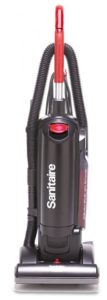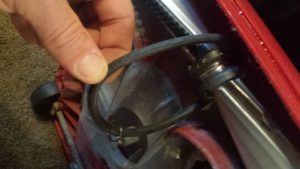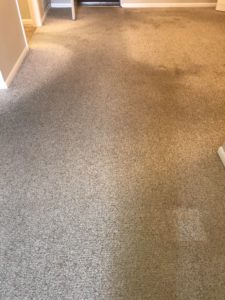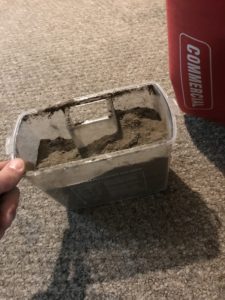 Your carpets act as a big filter for your house trapping many different types of soils; so vacuuming your wall to wall carpets and area rugs is one of the best things that you can do to extend the life and appearance of your textile. Vacuuming will also remove contaminants such as sand, lint, pollen, dead skin cells, dust mites, fleas, oil and grease, petroleum, and many other miscellaneous unknowns. Sand is actually a tiny rock with microscopic sharp edges all over its surface. Those sharp edges get ground against the fibers with foot traffic and cause scratches in the surface of your fiber. These scratches will reflect light differently than the rest of the carpet creating a visual contrast. While vacuuming regularly may not protect your carpet from all damage, if done correctly it can certainly extended the life and look of the fibers.
Your carpets act as a big filter for your house trapping many different types of soils; so vacuuming your wall to wall carpets and area rugs is one of the best things that you can do to extend the life and appearance of your textile. Vacuuming will also remove contaminants such as sand, lint, pollen, dead skin cells, dust mites, fleas, oil and grease, petroleum, and many other miscellaneous unknowns. Sand is actually a tiny rock with microscopic sharp edges all over its surface. Those sharp edges get ground against the fibers with foot traffic and cause scratches in the surface of your fiber. These scratches will reflect light differently than the rest of the carpet creating a visual contrast. While vacuuming regularly may not protect your carpet from all damage, if done correctly it can certainly extended the life and look of the fibers.
 Let’s start with your vacuum. Is it in good shape? Your vacuum is either a bag or canister vacuum. If you own a bag style make sure that it has a fresh vacuum bag. A vacuum breathes through pores in the bag so although it may seem as if the bag is only half full, clogged pores could cause a decrease in the amount of air flow that your vacuum can produce and causes poor suction. So, try to not let a bag get more than half way full. Canister style units should have the filters changed regularly. Usually filters are cheap and easily found at Wal-Mart or on Amazon. I would recommend changing them right along with your spring cleaning, maybe more often in more heavily soiled homes.
Let’s start with your vacuum. Is it in good shape? Your vacuum is either a bag or canister vacuum. If you own a bag style make sure that it has a fresh vacuum bag. A vacuum breathes through pores in the bag so although it may seem as if the bag is only half full, clogged pores could cause a decrease in the amount of air flow that your vacuum can produce and causes poor suction. So, try to not let a bag get more than half way full. Canister style units should have the filters changed regularly. Usually filters are cheap and easily found at Wal-Mart or on Amazon. I would recommend changing them right along with your spring cleaning, maybe more often in more heavily soiled homes.

Next, checkout your beater bar underneath the vacuum. Look for tangled hair, thread, and use a pair of scissors to remove whatever you find wrapped around the bar. While you’re inspecting the underside have a look at the belt. Some vacuums may require a little light disassembly to access the belt, usually around 4-6 small screws on the bottom of your vacuum. Once you’re in there test the belt tension. A loose belt will slip, causing poor beater bar rotation and rendering the vacuum useless. Belts can be had about as easily as bags and filters and at a minimal cost of around $6-8 dollars.
Once your vacuum is all tuned up, it’s time to start vacuuming. Most vacuums have a pile height setting for different levels of carpet. You will need to be one with your vacuum and listen to how the beater bar is reacting with the carpet fibers. You want the beater bar on the bottom of the vacuum to gently hit the tops of the fibers, vibrating the soil upward. If the beater bar is set too low your vacuum will usually alert you by sounding of bogged down and you may lose beater bar rotation due to strain on the belt. If the vacuum is set at too high of a pile height you will hear the vacuum revving high and you will not hear beater bar interact with the carpet fibers.

Observe the surface your trying to vacuum. Take mental note of entry ways, main walking paths, and even where you sit in your favorite chair. These are the areas you will need to concentrate on and slow your vacuuming pace through. Vacuuming in not an aerobic exercise! The slower you vacuum the more debris you’re going to remove from the carpet fibers. You need to give the beater bar time to separate the fibers and vibrate the soil out to be inhaled by the vacuum. Try to go slow in the traffic areas and if you feel the need to speed up somewhere, do to it next to a wall or in a less traveled area. Don’t forget about your carpet edges. The carpet beside the baseboard often gets missed by your vacuum and will collect a lot of contaminants settling there through your home’s air filtration patterns.
 Buy a carpet rake. The brand that I like best is by the company Grandi Groom. A carpet rake will remove all foot prints and vacuum marks and leave you with a visually even and cleaner looking carpeting. When used before vacuuming the rake can break apart deep soils and sand to allow for more productive soil removal. If you have an area rug with fringe the Grandi Groom will make it stick straight in seconds.
Buy a carpet rake. The brand that I like best is by the company Grandi Groom. A carpet rake will remove all foot prints and vacuum marks and leave you with a visually even and cleaner looking carpeting. When used before vacuuming the rake can break apart deep soils and sand to allow for more productive soil removal. If you have an area rug with fringe the Grandi Groom will make it stick straight in seconds.
 In the professional arena I have a record of 15 pounds of sand removed from one customer’s living room. I was vacuuming with two vacuums, one in each hand, for a good hour straight with several vacuum bags used. While vacuuming I crawled the vacuums slowly, barely moving across the area to pick up as much as possible. Anyone who has ripped up a carpet from a home will tell you how amazing it is that there was so much fine sand filtered under their carpet and pad.
In the professional arena I have a record of 15 pounds of sand removed from one customer’s living room. I was vacuuming with two vacuums, one in each hand, for a good hour straight with several vacuum bags used. While vacuuming I crawled the vacuums slowly, barely moving across the area to pick up as much as possible. Anyone who has ripped up a carpet from a home will tell you how amazing it is that there was so much fine sand filtered under their carpet and pad.
 Vacuuming once a week is fine for most homes. In some homes with large dogs I recommend vacuuming once a day. Pet hair and dander will pack itself into the carpet and leave a “dog smell” in your home. The more frequently and thoroughly you vacuum, the better the home will smell. Pet hair can become braided in the carpet fiber and be difficult to remove. There are multiple carpet fresh powders on the market that require you sprinkle the powder onto the carpet and then vacuum it out. However, I do not recommend applying powders to your carpet because it is actually quite difficult to completely remove with a standard vacuum. The remaining powder will act as dry soil scratching the carpet fibers and most of these products also contain chemicals that can negatively affect your indoor air quality.
Vacuuming once a week is fine for most homes. In some homes with large dogs I recommend vacuuming once a day. Pet hair and dander will pack itself into the carpet and leave a “dog smell” in your home. The more frequently and thoroughly you vacuum, the better the home will smell. Pet hair can become braided in the carpet fiber and be difficult to remove. There are multiple carpet fresh powders on the market that require you sprinkle the powder onto the carpet and then vacuum it out. However, I do not recommend applying powders to your carpet because it is actually quite difficult to completely remove with a standard vacuum. The remaining powder will act as dry soil scratching the carpet fibers and most of these products also contain chemicals that can negatively affect your indoor air quality.
After you have completed your vacuuming for the day, check out your bounty! With bag less vacuums you can easily observe all of the debris that you removed from your carpet. Take pride in your work, pat yourself on the back and enjoy your freshly vacuumed floors!

